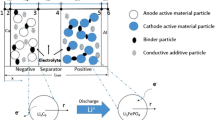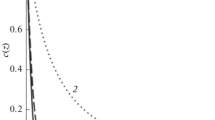Abstract
A computer simulation of the structure of the cathode active material in a lithium-ion battery is performed. The model of equal-sized grains of three types (active grains, grains of electrolyte, and carbon black grains) is studied. Acceptable bulk concentration of active grains g is estimated. It is in the range of zero to 0.3. Dependence of the key parameters of the electrode active material on its composition is determined: specific conductivity of electrolyte and specific surface area on which the electrochemical process occurs. It is shown that the average number of electrochemically active faces of active grains cannot be 100%, as usually assumed in the studies of diffusion processes occurring in an individual active grain. In the range of 0.0 ≤ g ≤ 0.3, the average number of active faces is in the approximate range of 2 ≤ ñ ≤ 3. The final choice of the optimum composition of components for the active material of a lithium-ion battery cathode (and, primarily, choice of the value for parameter g) requires performing an additional complex of computer simulations.
Similar content being viewed by others
References
Bagotskii, V.S. and Skundin, A.M., Khimicheskie Istochniki Toka (Chemical Power Sources), Moscow: Energoizdat, 1981.
Doyle, M., Fuller, T.F., and Newman, J., J. Electrochem. Soc., 1993, vol. 140, p. 1526.
Fuller, T.F., Doyle, M., and Newman, J., J. Electrochem. Soc., 1994, vol. 141, p. 1.
Doyle, M., Newman, J., Gozdz, A.S., Schmutz, C.N., and Tarascon, J.-M., J. Electrochem. Soc., 1996, vol. 143, p. 1890.
Arora, P., Doyle, M., and White, R.E., J. Electrochem. Soc., 1999, vol. 146, p. 3543.
Song, L. and Evans, J.W., J. Electrochem. Soc., 2000, vol. 147, p. 2086.
Gu, W.B. and Wang, C.Y., J. Electrochem. Soc., 2000, vol. 147, p. 2910.
Srinivasan, V. and Wang, C.Y., J. Electrochem. Soc., 2003, vol. 150, p. A98.
Doyle, M. and Fuentes, Y., J. Electrochem. Soc., 2003, vol. 150, p. A706.
Sikha, G., Popov, B.N., and White, R.E., J. Electrochem. Soc., 2004, vol. 151, p. A1104.
Chizmadzhev, Yu.A., Markin, V.S., Tarasevich, M.R., and Chirkov, Yu.T., Makrokinetika protsessov v poristykh sredakh (Macrokinetics of Processes in Porous Media), Moscow: Nauka, 1971.
Newman, J.S., Electrochemical Systems, New Jersey: Prentice Hall, Englewood Cliffs, 1991.
Tarasevich, Yu.Yu., Perkolyatsiya: teoriya, prilozheniya, algoritmy (Percolation: Theory, Applications, Algorithms), Moscow: Editorial URSS, 2001.
Chirkov, Yu.G., Rostokin, V.I., and Skundin, A.M., Elektrokhimiya, 2011, vol. 47, p. 65 [Russ. J. Electrochem. (Engl. Transl.), vol. 47, p. 59].
Chirkov, Yu.G. and Rostokin, V.I., Elektrokhimiya, 2004, vol. 40, p. 1036 [Russ. J. Electrochem. (Engl. Transl.), vol. 40, p. 898].
Chirkov, Yu.G. and Rostokin, V.I., Elektrokhimiya, 2003, vol. 39, p. 694 [Russ. J. Electrochem. (Engl. Transl.), vol. 39, p. 622].
Chirkov, Yu.G., Elektrokhimiya, 1999, vol. 35, p. 1452 [Russ. J. Electrochem. (Engl. Transl.), vol. 35, p. ].
Chirkov, Yu.G. and Rostokin, V.I., Elektrokhimiya, 2002, vol. 38, p. 1437 [Russ. J. Electrochem. (Engl. Transl.), vol. 38, p. 1299].
Korol’, V.I., Visual Basic 6.0 for Application, Moscow: KUDITs-OBRAZ, 2000.
Landsberg, G.S., Optika (Optics), Moscow: Fizmatlit, 2003.
Chirkov, Yu.G. and Rostokin, V.I., Elektrokhimiya, 2006, vol. 42, p. 799 [Russ. J. Electrochem. (Engl. Transl.), vol. 42, p. 715].
Skundin, A.M., Efimov, O.N., and Yarmolenko, O.V., Usp. Khim., 2002, vol. 71, no. 4, p. 378.
Zhang, Q. and White, R.E., J. Power Sources, 2007, vol. 165, p. 880.
Zhang, Q. and White, R.E., J. Power Sources, 2008, vol. 179, p. 793.
Author information
Authors and Affiliations
Corresponding author
Additional information
Original Russian Text © Yu.G. Chirkov, V.I. Rostokin, A.M. Skundin, 2011, published in Elektrokhimiya, 2011, Vol. 47, No. 1, pp. 77–89.
Rights and permissions
About this article
Cite this article
Chirkov, Y.G., Rostokin, V.I. & Skundin, A.M. Computer modeling of positive electrode operation in lithium-ion battery: Model of equal-sized grains, percolation calculations. Russ J Electrochem 47, 71–83 (2011). https://doi.org/10.1134/S102319351101006X
Received:
Published:
Issue Date:
DOI: https://doi.org/10.1134/S102319351101006X




